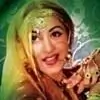RELIGIOUS DANCES
Most folk dances owe their existence to religion and are performed during fairs, festivals and other religious occasions celebrated by a local communities.
The dances like 'Nandi Dhwaja', 'Lingada-Berana', Gorava dance, Veeragase, Beesu Kamsale and Puravanthike are dedicated to the worship of Lord Shiva.
Bhagawanthike, Pata Kunitha and Bana Devara Kunitha are dances performed to worship Lord Vishnu.
Mariammana Kunitha, Urimarammana Kunitha, Puja, Karaga, Dollu, Soman Kunitha, Harige, Sedere, Bhoota Nrutya, Naga Nrutya, Vatte Kola, Kombat and Billat are being performed to worship all incarnations of 'Shakti', the deity of power.
The dance performance in Nandi Dhwaja consist of an attractively decorated bamboo pole measuring about 20 to 25 feet long and 4 inch wide in circumference. Nandi Dhwaja is performed by skilled and experienced dancers. The performance begins with the erection of the Nandi pole which is initially thrust into a 'Navara'-the pouch worn by the performer. Balancing the pole at 90o , the dancer accomplishes rhythmic movements and intricate acrobats to the emotional tunes of the musical accompaniments. This dance is prevalent in all parts of the state except Kodagu.
The artistes of Beesu Kamsale are an expert singing community. But vigorous, rhythmic movements dominate the performance of Beesu Kamsale. Narration is regulated to the background.
In Pata Kunitha, the major emphasis is more on the manipulation of pata (embellished bamboo pole, each measuring 10 to 15 feet high, carried by 10 to 15 artistes) than the narration. The dances Beesu Kamsale and Pata are widely popular in Mysore region.
In Bana Devara Kunitha, the folk artistes will be preoccupied with attaining perfect harmony to the clinking of bow bells rather than on oral communication of any religious content. The striking feature of this dance is archery. This form of dance is found in places like Hassan, Chitradurga and Chikkamagulur.
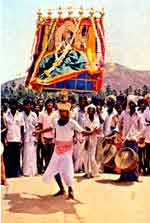 In Puja Kunitha dance, the emphasis is more on the visual presentation than the oral narration. Here the spectacular exhibition of colourful bamboo structure is ably matched by the skilful body movements. It is prevalent in Bangalore and Mandya districts.
In Puja Kunitha dance, the emphasis is more on the visual presentation than the oral narration. Here the spectacular exhibition of colourful bamboo structure is ably matched by the skilful body movements. It is prevalent in Bangalore and Mandya districts.
Karaga is known for its rigidity with high ritualistic significance. It is popular in Mysore and Bangalore districts.
In Sedere dance, the performance in an emotion charged atmosphere. Any communication through music gets drowned in the din of the thunderous sound of musical instruments amidst fast paced virile performance. Sedere is performed by scheduled castes and washer men in some parts of Bangalore and Hassan districts.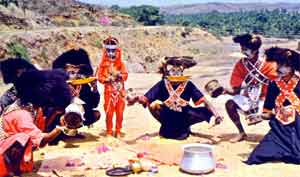
In Gorava mela which is extensively practiced in Mysore, Shimoga, Belgaum and Dharwad districts, the artistes display immense abilities of oral communication and perception. Goravas are singing tribe who narrates stories of deeper religious value.
Dollu, a group dance which is widely practiced in Melkote in Mandya district offers a desirable atmosphere for the integration of new ideas in an unusual way, through interaction and exchange of information between the two groups of performers. Dollu, a semi circular dance, with a brilliant combination of sound and speed, performed by the Kurub community in North Karnataka, Shimoga and Chitradurga districts is worth noting. The soul of Dollu Kunitha is the indigenous folk instrument called Dollu which when struck emits a thunderous sound. Mythological, historical and social themes are narrated by the chief narrator with the powerful musical accompaniment consisting of the Dollu, the cymbals and the flute providing appropriate musical setting to the narration. Messages on loan melas, small savings, adult education and population control programmes have been integrated into this folk dance.
Bhagavanthike involves a competition of a witty dialogue between two groups of 10 to 12 artistes, who wearing spectacular costumes recreate the fanciful tradition of folk dance. Bhagavata, who is the chief narrator cum performer makes the folk dance of Bhagavanthike, a viable medium of non-formal communication. There is also a jester. During the performance, the jester sings and dances along with other artistes sometimes following the traditional and sometimes setting up new precedents and serves as a change-agent. Attracting wider attention through his acrobatics, the jester skillfully adapts himself to the changing needs and demands of the audience eventually establishing a rapport with the audience with ease.
The community dance, Mari Kunitha which is wide spread in Mysore and Mandya districts, display an insular flexibility in the presentation and narration. Originally belonging to the Shakti cult, these dances consist of performers standing either in rows or forming a big circle and dancing to the tune of 'Chakravaddya', an indigenous flat percussion instrument. The dance begins at a slow pace, gathers momentum, reaches a frenzied pitch as the tempo of the beat increases and continues till the rhythm fades away. The songs are sung intermittently at each pause and hence could be heard by the audience clearly. In the dances like Kombat and Billat, which is similar to the Mari Kunitha, the artistes attired in customary 'Kodava' costume (consist of black robe, a silk waist belt and a 'Zari' bordered white turban) perform carrying deer-horns to the accompaniment of a drum and the dudi- a small drum.
The folk dance of 'Urimaramma' is performed by a team of a husband and wife. The artistes are nomads, wandering from one place to another carrying an unusually designed mobile temple, eventually facilitating a simultaneous performance of dance and worshipping of the deity, right at the door of the people. The performer, acting like a messenger emphasises on a social problem and he tries to motivate the people to invoke the blessings of the deity so as to enable them to overcome an impending crisis.
Dances like
Harige, Bhoota Nrutya, Naga Nrutya and Vatte 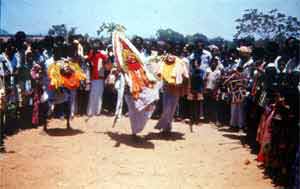 Kola
Kola aim at appeasing the supernatural powers, lest the community is harmed. These dances are deep rooted particularly in the picturesque coastal region of South and North Karnataka. The dance serve as a traditional forum for community members to conduct a dialogue with the performer - the re-creator of ghost image, consequently paving way for a two way communication. The image of the ghost is most appealing.
In the coastal region of South Kanara, the Bhoota Nrutya takes different forms, depending upon the type of the ghost it represents. Koratti, Koraga Taniya, Ali Bhoota, Punjurli, Kuppe Punjurli, Kalkuda, Kallurti, Shiradi Bhoota and many others represent a galaxy of ghosts worshipped in places like Puttur, Mangalore, Bantwal and Uppinangadi.
The chief narrator of the Naga Nrutya (snake dance) is known as Vaidya or Patri. The dance is performed with religious fervour to appeal to the religious susceptibilities of the people.
Vatte Kola is another folk dance that comes under the umbrella of the Bhuta tradition. It is dedicated to ghost worship. The presentation of Vatte Kola begins with the preparation of burning coal in an open field. The performers are required to walk over the burning charcoal pits. The performer of Vatte Kola is an excellent communicator who steals the show through his sincere worshipping of deity for the total welfare of the community.
Lingada Birana Kunitha which is wide spread in the southern parts of the state and where the dancers perform splendidly, holding a sword in one hand and a shield bearing their religious emblem in the other to the tune of the devotional narration.
Puravanthike is a highly expressive and credible narrative art which draws its strength from the heavy sprinkling of riddles in its content. These riddles are folksy, woven around familiar things of daily life and also amuse people in the form of simple folk poetry and they serve as excellent channels of social education. In Puravanthike the costumes and ornaments are colourful. Dressed like warriors, the dancers present a skilful display of vigour with a sword in one hand and a trident in the other.
SECULAR DANCES
If religious dances arouse religious sentiments of the people, the secular dances provide entertainment. Kolata, Chit mela, Marakalu Kunitha, Chennu Kunitha and Simha Nrutya are some of the important secular folk dances in the state.'
'Chit mela' which is performed by a group of ten artistes and is replete with colourful exhibition of eye-catching presentation is dominated by an unusual butterfly like display.
The folk art of 'Chennu Kunitha', the harvest dance found in Puttur, Coondapura and other villages of South Kanara give an insight into the cheapest mode of communication through entertainment.
The folk dance of 'Maragalu Kunitha' consist of unique wooden legs which the artistes literally wear to gain unusual height. Wearing uniquely designed artificial legs the artiste easily captures the attention of the people through executing impressive but difficult feats.
Kolata or stick dance is a kind of valour dance involving groups of people who indulge in bending, swaying and jumping activities to the tune of rhythmic clashing of sticks. With two sticks in hand, each dancer can strike in various patterns and rhythms. There is considerably more flexibility in the pattern of dancing so also singing. Members of Vokkaliga, Nayaka and Golla communities of Mysore, Mandya and Hassan districts and the Hallakki Gowda community of North Karnataka and the Kodavas of Coorg excel in Kolata. There is a rich spread of romantic and valour themes and references to contemporary, political and social issues in Kolata songs.
'Alayi Hejje', a semi religious dance of the Muslim community of Karnataka, is a classic illustration of harmony between the two predominant communities of India, the Hindus and the Muslims. Jointly performed by both Muslims and Hindus, the presentation in Alayi Hejje consists of performers dancing around a fire pit. It appears like a rope dance with 20 to 25 dancers holding identical ropes which are hung from bamboo poles. The dancers form a circle and dance around the pole artistically winding and unwinding the ropes like plaits.
Alayi dance is an amalgamation of action and dexterous footwork, supported by appropriate devotional theme. Performed as part of 'Muharram' festival, Alayi Hejje provides a favourable forum for accomplishing the much needed communal amity in this much diversified society. Serving as a symbol of communal harmony, the theme of Alayi Hejje can be explored for other purposes, than it presently expounds on the stage, besides its religious functions.
The folk dance which is totally free from ritualistic and religious barriers is 'Simha Nrutya' (lion dance), the popular dance of the Honnavara taluk in the Uttara Kannada districts, usually performed by 'Yakshagana' artistes. The dance is in effect a charming imitation of a lion's movements. Hence the dancer wears a costume which closely resembles the lion. The costume is specially made of bark and yarn using natural dyes. The dancer wears a mask which is made up of cotton and is done to look like a lion's face. Two silver pangs are inserted in the mouth to create a visual impression of fangs. With the perfect portrayal of a lion's behaviour, movements, mode of hunting and preying, Simha Nrutya is not only entertaining but educative also. Simha Nrutya, generally performed during the Yakshagana play is attracting attention and has been used in the propagation of messages like preservation of wild life, dangers of deforestation, dangers of poaching etc.








 Ummattat
Ummattat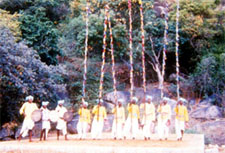
 In Puja Kunitha dance, the emphasis is more on the visual presentation than the oral narration. Here the spectacular exhibition of colourful bamboo structure is ably matched by the skilful body movements. It is prevalent in Bangalore and Mandya districts.
In Puja Kunitha dance, the emphasis is more on the visual presentation than the oral narration. Here the spectacular exhibition of colourful bamboo structure is ably matched by the skilful body movements. It is prevalent in Bangalore and Mandya districts.
 Kola aim at appeasing the supernatural powers, lest the community is harmed. These dances are deep rooted particularly in the picturesque coastal region of South and North Karnataka. The dance serve as a traditional forum for community members to conduct a dialogue with the performer - the re-creator of ghost image, consequently paving way for a two way communication. The image of the ghost is most appealing.
Kola aim at appeasing the supernatural powers, lest the community is harmed. These dances are deep rooted particularly in the picturesque coastal region of South and North Karnataka. The dance serve as a traditional forum for community members to conduct a dialogue with the performer - the re-creator of ghost image, consequently paving way for a two way communication. The image of the ghost is most appealing. 